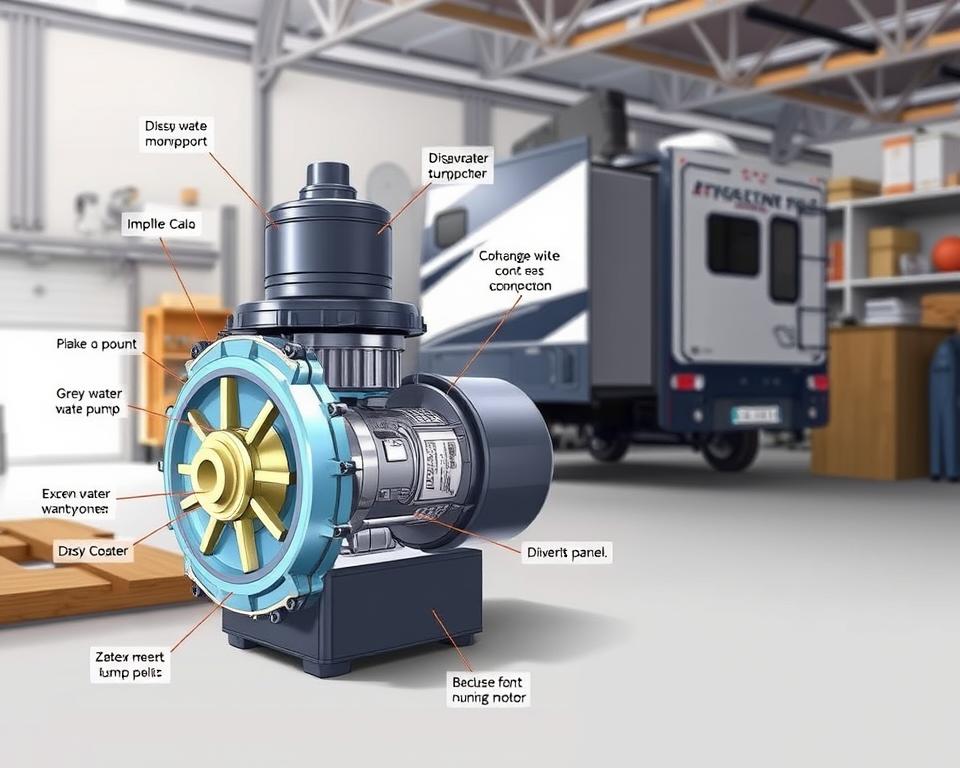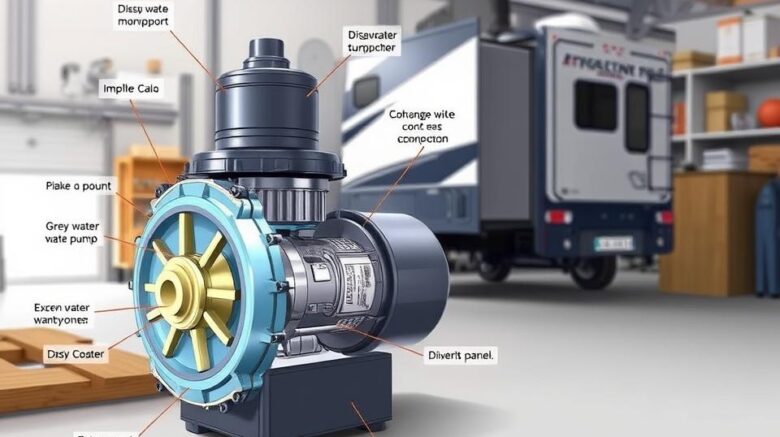Septic Air Pump: Comprehensive Guide for Householders
Curious about what drives your oxygen-based Septic system’s effectiveness? The Septic tank aerator is the often-overlooked key component integral for your system. With this resource, homeowners will obtain valuable information on the aerator’s importance. It’s essential for a sound, well-run Septic tank.
Grasping the necessity of a Septic tank air Pump can boost your Septic system’s functionality using RV tank pumping. It also secures your asset value and ecological well-being. Our handbook will introduce All in Sanitation, a leading Septic industry authority. They’re eager to handle your Septic aerator Pump requests.
Primary Highlights
- The Septic air Pump is indispensable for aerobic Septic systems.
- Properly caring for your Septic system air Pump can improve overall system function.
- Routine inspections lengthen the service life of your Septic tank air Pump.
- Choosing the best-fit Septic aerator Pump is critical for peak operation.
- All in Sanitation delivers expert services for Septic air Pump solutions.
Exploring Aerobic Septic Solutions
Aerobic Septic systems deliver a more effective waste treatment option by using oxygen. This method features aerobic bacteria flourishing in well-oxygenated environments. These bacteria are faster in decomposing organic matter. With the help of Septic aerator Pumps, these systems provide a constant oxygen supply, boosting the waste decomposition process.
These systems shine in minimizing sludge buildup, owing to the activity of aerobic bacteria. This cut in solid waste means minimal cleaning and periodic Pump service is required less often. Additionally, they effectively manage wastewater, producing minimal smells. This yields a better environment for homeowners and the community as a whole.
To guarantee these systems run properly, it’s crucial to know the key Septic system components. These include the Septic tank, oxygenation chamber, and effluent Pump. Each section serves a key function, especially the air Pump. It pushes oxygen into the tank, crucial for the aerobic bacteria’s performance.
Role of the Septic Air Pump
The Septic air Pump is central in the operation of aerobic Septic systems. It serves as the system’s “lungs,” supplying the necessary oxygen required. This oxygen enables aerobic bacteria to prosper and decompose waste efficiently. If the Pump stops, the system’s efficiency decreases, leading to sludge increase and possible odors.
Such issues can interfere with Septic system operations and cause environmental hazards. By recognizing how critical the Septic air Pump is, homeowners can take proactive steps. They can ensure its peak function through scheduled service. This wards off failures, sidesteps costly repairs, and keeps the aerobic system’s condition.
Major Benefits of Using a Septic Air Pump
Employing a Septic air Pump notably enhances the capability of Septic systems. Septic air Pumps are vital as they accelerate the processing of waste. This is done by oxygenating the treatment process, encouraging aerobic bacteria growth. These bacteria are vital for proper waste treatment.
They’re also important in cutting foul smells. With more active aerobic processes, waste breaks down faster, thus diminishing odors. This makes the environment more pleasant for homeowners.
Another noteworthy benefit is the drop in sludge accumulation. Consequently, tanks need less frequent Pumping, cutting both money and time. Better processing not only saves costs but also lengthens the lifespan of the drain field.
Proper care of these Pumps properly means fewer repair costs and meeting regulatory standards. Thus, the pluses of Septic air Pumps go beyond being for homeowners. They also support environmental health by advancing waste management practices.
| Benefit | Description |
|---|---|
| Fast Waste Breakdown | Greater aerobic activity accelerates the decomposition process. |
| Minimized Odor Emissions | Superior treatment efficacy produces fewer odors. |
| Reduced Sludge Buildup | Less frequent Pumping and maintenance are required. |
| Extended Drain Field Life | Better treatment translates to a healthier drain field. |
| Cost Savings | Lower probability of repairs and regulatory compliance cost. |

Finding a Suitable Septic Air Pump
Selecting the right Septic air Pump is essential for an efficient aerobic system. Homeowners ought to review various factors for the best fit. The volume of the tank and the airflow demands play a crucial role the Pump’s output.
To make an informed choice, it’s important to know the air Pumps available. There are mainly two types: diaphragm Pumps and rotary vane Pumps. Each provides specific strengths, which should be paired with your home’s specific needs and how it operates.
Power consumption also should be considered. Choosing a Pump that lowers energy use while delivering the needed airflow can lead to noticeable cost cuts. Help from All in Sanitation professionals can be invaluable. They confirm the Pump you choose meets your system’s requirements perfectly.
Typical Classes of Septic Air Pumps
Homeowners can decide more effectively by knowing the different Septic air Pumps available. There are mainly two types: diaphragm Pumps and rotary vane Pumps. Each has its specific functions and benefits.
Diaphragm Pumps, famous for their quiet operation, are popular for residential Septic systems. They deliver energy efficiency while delivering reliable air delivery. Their dependable performance is ideal for smaller systems, preferred by many homeowners.
Rotary vane Pumps, however, are better suited for higher-capacity or commercial systems. These Pumps deliver increased power, necessary for handling bigger loads. Their strong build delivers efficient operation in large-scale Septic systems.
| Type of Pump | Best Use | Advantages |
|---|---|---|
| Diaphragm Pumps | Residential Systems | Quiet operation, energy-efficient, reliable air flow |
| Rotary Vane Pumps | Larger or Commercial Systems | Powerful performance, high capacity, durable construction |
Recognizing the variations in Septic air Pumps is vital for upgrades or replacements. Each Pump type provides specific features to address various needs. This provides top performance for any system.
Indicators You Require a Septic Air Pump Replacement
Homeowners must be alert to Pump failure signs in their Septic systems. Some signals indicate the need for a Septic air Pump replacement. These help maintain smooth operation. Identifying these early prevents serious issues.
Signs of potential problems include:
- Unusual noises from the Pump, like grinding or buzzing, might mean internal damage.
- A clear lack of air output suggests the Pump isn’t working well, harming efficiency.
- Regular electrical problems, such as circuit trips or voltage drops, could show overloading.
- Visible damage on the Pump unit, with breaks or leaks, calls for quick action.
- Offensive smells in the yard often signal a compromised Pump, meaning ineffective effluent aeration.
Finding these signs early avoids pricey restoration or total system failure. Performing periodic reviews makes it easy to catch these issues. It also demonstrates if you require a new Septic air Pump.
Upkeep Advice for Your Septic Air Pump
For an efficient Septic air Pump, periodic care is necessary. This makes sure that your system works smoothly. Homeowners can use several simple care strategies for best results.
Half-yearly, carry out a comprehensive inspection for wear or damage. It is also essential to replace the filters as advised. This stops clogs that could hamper efficiency.
The Pump should stand on a firm base to lessen vibrations, which could wear it over time. A protective cover is critical too. It guards against debris and water, keeping the Pump’s functionality.
Good upkeep can significantly lengthen the life of your Pump. In turn, this benefits the Septic system’s performance collectively.
| Maintenance Task | Frequency | Benefits |
|---|---|---|
| Inspect Pump for damage | Every 6 months | Finds faults promptly |
| Replace filters | As needed | Improves efficiency |
| Check surface stability | Annually | Limits wear |
| Clear debris around Pump | Monthly | Stops blockages |
Fitting Your Septic Air Pump
Accurate installation of your Septic air Pump is key for its efficient operation. Initially, select a reliable, moisture-free area for placement. The chosen spot should securely support the Pump’s weight easily.
To effectively install your Pump on your own, observe the following guidelines:
- Collect all necessary items, including the Pump, a power source, and hose fittings.
- Consult the manufacturer’s guidelines before starting your installation.
- Confirm every connection is tight to eliminate air leaks that reduce performance.
- After assembly, complete a test to verify the system works as intended.
If the installation process looks challenging, get in touch with All in Sanitation. Their professionals can avoid common errors, guaranteeing your setup follows mandatory safety requirements.
Benefits of Choosing All in Sanitation for Your Septic Air Pump Requirements
When selecting a Septic service provider, the choice is significant. All in Sanitation sets itself by providing dependable Septic air Pumps. They satisfy varied homeowner requirements with a extensive selection of premium products. This makes sure customers find an appropriate match for their Septic systems.
What really sets apart All in Sanitation is not solely their diverse product lineup. Their commitment to outstanding customer service is also critical. Homeowners benefit from knowledgeable support, guiding them towards trusted Septic solutions. This partnership is crucial to tailor each solution to satisfy specific needs.
All in Sanitation also focuses on aftercare to ensure lasting satisfaction. Their dedication extends beyond the initial sale. They offer ongoing support to preserve Septic systems running smoothly for the long term.
Cost Considerations for Septic Air Pumps
Grasping the financial elements tied to Septic air Pumps is important for homeowners who run aerobic Septic systems. At first, one faces the purchase price, which includes the Pump and associated accessories. Installation expenses change, based on the system’s complexity and any alterations required.
Ongoing upkeep forms an additional cost layer. Consistent assessments can head off bigger issues, in the long run yielding savings. Homeowners should budget for Septic maintenance to maintain the Pump’s effectiveness and service life. Such planning sidesteps expensive repairs later on, demonstrating the advantage of proactive maintenance.
| Cost Component | Average Cost Range |
|---|---|
| Septic Air Pump | $500 – $1,200 |
| Installation | $300 – $800 |
| Annual Maintenance | $150 – $400 |
| Potential Repair Costs | $1,000 – $5,000 |
Itemizing Septic air Pump expenses into distinct parts assists homeowners in budgeting. This thorough approach provides the system’s steady performance and their comfort.
In Summary
For homeowners with aerobic Septic systems, caring for Septic units is key. The suitable Septic air Pump boosts waste processing and prolongs your system’s life. Sticking with routine maintenance and quickly fixing issues sidesteps large repair bills and disruptions.
Choosing a Septic air Pump requires consideration. This guide showed how to select effectively about installation and replacement. With All in Sanitation’s help, you can tackle your Septic systems’ complexities confidently.
Taking care of your Septic air Pump supports your system’s operation and service life. It guarantees a efficient and proper operation over time. Don’t forget, your home’s wastewater management benefits greatly from consistent upkeep.
